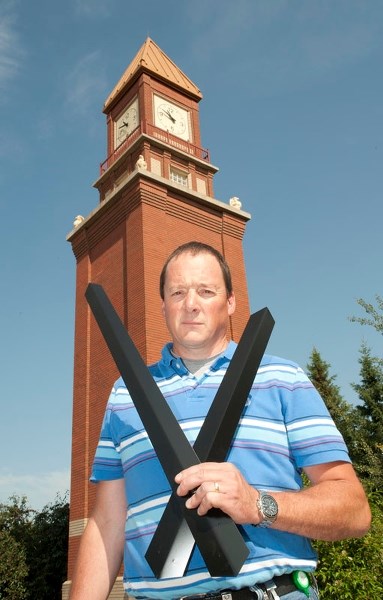Ronnie Nyenhuis will have one busy Saturday as she gears up for the end of daylight savings time.
She and her husband Hess have scads of clocks between their St. Albert home and their Golden Hour Clock Shop in west Edmonton, many of which they’ll have to crank back an hour by 2 a.m. Sunday morning.
“We have some really smart ones that set themselves,” she says, but as most of them are antique mechanical clocks, that means they have to set many by hand.
Nyenhuis says she only sets about six of them at the shop, but does roughly two dozen at home, including two grandfathers, two cuckoos, a French and a dozen miniature novelty ones shaped like owls, windmills and the Eiffel Tower.
“We’re clock freaks,” she says, laughing.
“We’ve got them everywhere.”
Daylight savings time ends at 2 a.m. this Sunday. That means it’s time to set your clocks back an hour and switch to standard time.
It will be up to city asset management supervisor Doug Moore and his team to reset one of the biggest clocks in St. Albert: the Perron Street clock tower.
The clock tower actually has a separate clock for each of its faces, Moore notes. You set them using controls at the base of the tower.
While crews could use those controls to crank the clocks back an hour, it would be very cumbersome, Moore says – you have to set them each individually (as they don’t move in sync), and you need one person inside at the controls while another stands outside to watch the hands.
What do they do instead?
“Honestly? We go there, shut the power off for an hour and come back.”
They leave it off for 11 hours when it’s time to spring ahead.
No one’s complained so far, he notes.
They plan to stop the clock at about 8 p.m. Saturday if you happen to set your watch by it.
Daylight savings time was first proposed by U.S. inventor Benjamin Franklin in 1784, where he suggested the idea (somewhat facetiously) as a way to use fewer candles, reports timeanddate.com.
Germany was the first nation to actually implement it, setting its clocks ahead an hour on April 30, 1916, to save energy during the First World War. About 70 nations now use various forms of daylight savings time as an energy-saving measure.
Most studies have found that daylight savings time saves little to no energy, with some suggesting that it wastes more.
A 2008 study of Indiana by Matthew Kotchen found that residents used about one per cent more electricity after the state-wide introduction of daylight savings, costing them about $9 million more in electricity, for example – any savings on lighting were replaced by additional spending on cooling caused by having an extra hour of daylight in the summer. Other studies have found a similar effect for having an extra hour of darkness in the winter.
Nyenhuis says she knows it’s not necessary to reset every clock in her home, but says it’s annoying to look at one and know that it’s got the wrong time – even if it’ll be right again in six months.
“It’s not really a big chore for me,” she says.
“It’s great fun!”




